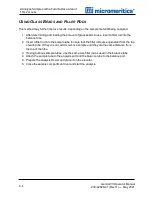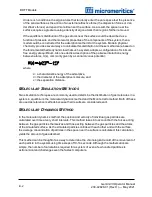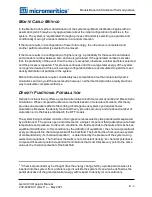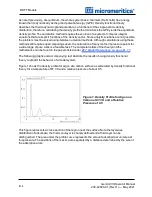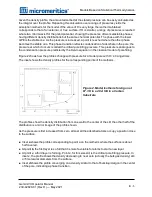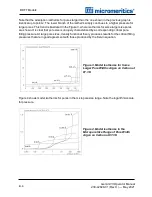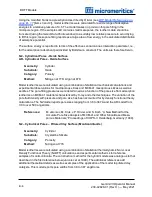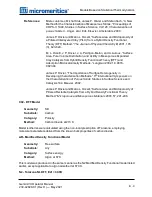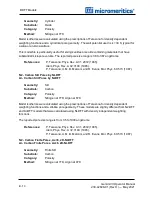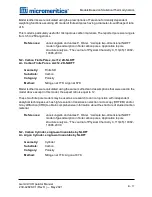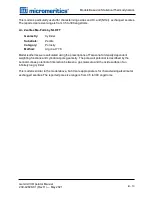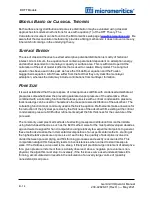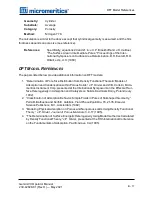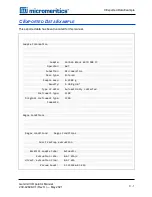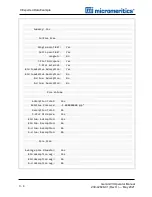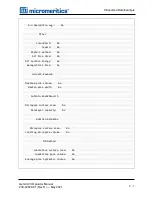
B DFT Models
M
ODELS
B
ASED ON
C
LASSICAL
T
HEORIES
Both surface energy distribution and pore size distribution may be evaluated using classical
approaches to model kernel functions for use with equation (1) of the DFT Theory. The
Calculations
document can be found on the Micromeritics web page (
). Be
aware that the deconvolution method only provides a fitting mechanism; it does not overcome any
inherent shortcomings in the underlying theory.
S
URFACE
E
NERGY
The use of classical theories to extract adsorptive potential distribution is mostly of historical
interest. At a minimum, the equation must contain a parameter dependent on adsorption energy
and another dependent on monolayer capacity or surface area. This is sufficient to permit the
calculation of the set of model isotherms that is used to create a library model. The Langmuir
equation has been used in the past, as have the Hill-de Boer equation and the Fowler-
Guggenheim equation. All of these suffer from the fact that they only describe monolayer
adsorption, whereas the data may include contributions from multilayer formation.
P
ORE
S
IZE
It is well established that the pore space of a mesoporous solid fills with condensed adsorbate at
pressures somewhat below the prevailing saturated vapor pressure of the adsorptive. When
combined with a correlating function that relates pore size with a critical condensation pressure,
this knowledge can be used to characterize the mesopore size distribution of the adsorbent. The
correlating function most commonly used is the Kelvin equation. Refinements make allowance for
the reduction of the physical pore size by the thickness of the adsorbed film existing at the critical
condensation pressure. Still further refinements adjust the film thickness for the curvature of the
pore wall.
The commonly used practical methods of extracting mesopore distribution from isotherm data
using Kelvin-based theories, such as the BJH method, were for the most part developed decades
ago and were designed for hand computation using relatively few experimental points. In general,
these methods visualize the incremental decomposition of an experimental isotherm, starting at
the highest relative pressure or pore size. At each step, the quantity of adsorptive involved is
divided between pore emptying and film thinning processes and exactly is accounted for. This
computational algorithm frequently leads to inconsistencies when carried to small mesopore
sizes. If the thickness curve used is too steep, it finally will predict a larger increment of adsorptive
for a given pressure increment than is actually observed; since a negative pore volume is non-
physical, the algorithm must stop. Conversely, if the thickness curve used underestimates film
thinning, accumulated error results in the calculation of an overly large volume of (possibly
nonexistent) small pores.
B - 14
Gemini VII Operator Manual
239-42828-01 (Rev H ) — May 2021
Summary of Contents for GEMINI VII
Page 1: ...OPERATOR MANUAL 239 42828 01 May 2021 Rev H GEMINI VII SURFACE AREA ANALYZER ...
Page 10: ......
Page 16: ......
Page 92: ......
Page 126: ...6 About Reports SAMPLE LOG REPORT 6 34 Gemini VII Operator Manual 239 42828 01 Rev H May 2021 ...
Page 127: ...T PLOT REPORT t Plot Report Gemini VII Operator Manual 239 42828 01 Rev H May 2021 6 35 ...
Page 128: ...6 About Reports VALIDATION REPORT 6 36 Gemini VII Operator Manual 239 42828 01 Rev H May 2021 ...
Page 234: ......
Page 242: ......
Page 244: ......
Page 247: ......
Page 248: ......

